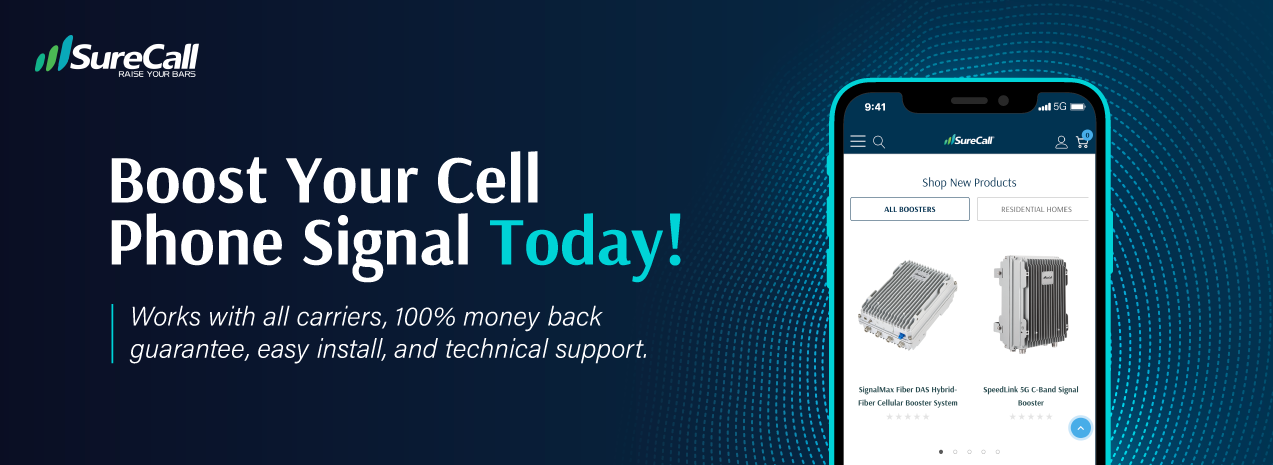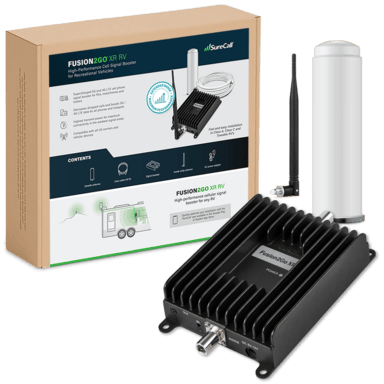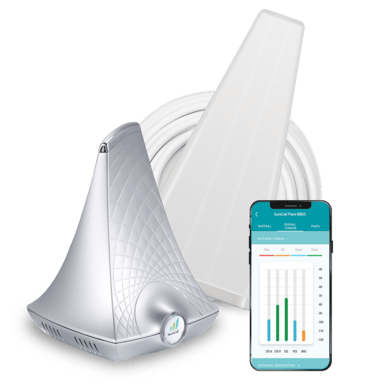
Cellular Phone Frequency Bands Guide 2024
Posted by Greg Knell on 1st Feb 2022
For many consumers out there, the technology and importance of radio waves to cell phones is out of sight/out of mind. Most people use their smartphone every day without truly knowing what makes its functionality possible. This updated cellular phone frequency bands guide explains this information simply as well as how this knowledge is helpful to everyone who uses a cell phone.
Table of Contents
- Cellular Phone Frequency Bands: What Are They?
- What Frequency are Cell Phones?
- Why Do Cellular Carriers Use Multiple Frequencies?
- Cellular Phone Frequency Bands: How Do They Work?
- A Little More About Cellular Phone Frequency Bands
- More Terms To Know
- Cellular Phone Frequency Bands By Carrier
- Why are Cellular Frequencies Important?
- How Do I Know Which Frequency Bands My Device Supports?
Of all the individual technologies and components that allow your smartphone to function, radio waves are perhaps the most important. Your smartphone must connect to a mobile network in order to browse the web, stream videos, send text messages, and make calls. And it can’t connect to a mobile network without radio frequencies.
For many consumers out there, the technology and importance of radio waves as pertaining to their cell phone is out of sight/out of mind. But this knowledge is very helpful to technology nerds and lay-people alike. Certain bandwidths and networks may serve your area better than others. Not every provider uses the same frequencies. Some devices are compatible with certain radio frequencies and not others. All of this information proves very helpful, for instance, to people thinking about switching carriers or to people who are in the market for a new device.
Cellular Phone Frequency Bands: What Are They?
As you may remember from high school science, the number of sound waves that occur per second is the definition of a frequency. Frequencies are measures in Hz (Hertz). If the sound waves are moving fast, these are higher frequencies. If they’re moving slowly, these are lower frequencies. We categorize frequencies into groups called spectrums. For example, the spectrum that comprises the range from 3 kHz to 300 GHz is called the RF spectrum. This is where all cellular frequencies fall.
In an attempt to organize spectrum and frequency use in America, the US government tasks the FCC (Federal Communications Commission) and the NTIA (National Telecommunications and Information Administration) with leasing them to cellular carriers. These two agencies divide the spectra into what we call bands (multiple ranges of frequencies). The majority of cellular bands are between 600 MHz and 39 GHz, which is part of the RF spectrum, as previously mentioned. The carrier and device you use determines what specific frequencies your personal device is linked to for your service.
One thing to remember is that a band represents many frequencies - not just one - as is sometimes mistakenly assumed. The 700 MHz frequency, for instance, includes all frequencies between 699 MHz and 798 MHz.
What Frequency are Cell Phones?
Cell phones operate using radio frequencies within the RF spectrum, typically between 600 MHz and 39 GHz. The FCC and NTIA manage and license these frequencies to carriers in bands, each containing multiple frequencies. High frequencies offer faster data transmission but lower range and obstacle penetration, while low frequencies provide better penetration with slower data rates, ideal for urban areas. Compatibility between a phone and its carrier's frequency bands is essential for effective communication and functionality.
Why Do Cellular Carriers Use Multiple Frequencies?
In order for a cellular carrier to use a given cellular band, they need a license for it, which is given by the FCC. In most cases, when a cellular carrier is given license to a particular band, a small section of that band is all the carrier is allowed to use. These small sections are referred to as channels or blocks (either term is acceptable). The reason it is set up this way is to avoid carriers interfering with each other. Some bands are used by multiple carriers, but by allotting particular channels of use per carrier, they can use the same band without interference. In other words, bands are not exclusive to one carrier, but channels are (or at least can be, depending on the license).
Because these various channels are located on different sections of the RF spectrum, naturally some of them consist of low frequencies and some of them are high frequencies. High frequencies can transmit data faster than low frequencies, but they can’t penetrate obstacles (buildings, hills, trees) as well, and they can’t travel as far. Low frequencies are the opposite. They are much better at penetrating obstacles but have lower data transmission rates. Though it may seem counterintuitive on the surface, lower frequency bands are better for metropolitan, urban areas.
So, if a carrier wants to have the most reliable network possible, they seek to gain as many licenses throughout the RF spectrum as possible.
Cellular Phone Frequency Bands: How Do They Work?
After all that, let’s talk about your phone; the one you’re likely holding right now. In order for your cell phone to work, it needs to have access to the frequency bands that your carrier uses. This is usually done automatically for you when you sign up with a carrier. Your carrier - especially if you’re with a major one - uses a range of frequencies. And it’s via these frequencies that your phone is able to transmit information. When your phone communicates with your nearest cell tower, it’s doing so through your carrier’s specific frequency bands.
A Little More About Cellular Phone Frequency Bands
When acquiring frequency licenses from the FCC, carriers usually follow a blueprint of sorts to make sure the bands they're purchasing don’t interfere with other carrier’s bands. They purchase them in sets of three; one in the middle (a guard band) and two on the outside. This “blueprint” is called FDD (Frequency Division Duplex). Carriers that acquire their bands in this way increase the odds that their data and voice transmissions will operate at maximum efficiency.
Another way carriers go about purchasing frequency bands is called TDD (Time Division Duplex). It’s not as effective as FDD because it uses a single band for downlink and a single band for uplink (rather than the 3-band approach of FDD). Though to the end-user, the difference between the two methods is probably unnoticeable, carriers are prone to experience more problems in their network in a TDD scenario.
More Terms To Know
3G
A mobile telecommunications system that can only handle things like text, talk, and very basic mobile internet. It was widely used in the 2000s. 3G stands for third-generation.
4G
A mobile telecommunications system that can handle text, talk, and data-heavy, fast internet. 4G essentially made mobile apps possible (iTunes, Spotify, Google Maps, Google Chrome, Safari, Facebook Netflix, Hulu, YouTube). It was widely used in the 2010s and is still widely used today. 4G stands for fourth-generation.
LTE
Considered the global mobile standard for many years now, LTE is a subform of 4G. It allows mobile phones to work across countries by automatically accessing differing frequencies depending on what country the phone happens to be in. LTE stands for long-term evolution. It quickly replaced WiMax, which was the first 4G standard.
5G
The newest telecommunications system. Though it has not yet reached its potential, 5G infrastructures are well on their way. It’s expected to be twenty times faster than 4G LTE, causing an evolution of what IoT is capable of. 5G stands for fifth-generation. It's typically a blanket term for all speeds above 100 Mbps, and can operate on the lower, mid-, and high-band frequencies. For this reason, all SureCall cell phone signal boosters will continue to boost your phone's signal for years to come.
Mid-Band or C-Band
In the US the C-Band is between 3.7 to 3.98GHz. Because it's in the middle of the higher frequency mmWave and lower frequencies currently used for 4G LTE, it's literally in the middle by performance as well. It's capable of higher speeds than lower frequencies, and can cover greater areas than higher frequencies, though each is better at the opposite in their respective areas. Sascha Segan has a great article on C-Band that's worth the read.
Millimeter-wave
Frequency waves in the 30-300 GHz range inside the RF spectrum. mmWave can handle massive amounts of data movement at the same time with ultra-low latency. The full impact of this frequency will be realized over the next few years.
Cellular Phone Frequency Bands By Carrier
Here is the list of the frequencies and bands that major US carriers use as of April 2021. Each frequency is noted as 5G, 4G, or 3G.
| Carrier | 5G Frequencies (Bands) | 4G Frequencies (Bands) | 3G Frequencies (Bands) |
| AT&T | 850 MHz (Band n5), 39 GHz (Band n260) | 700 MHz (Bands 12/17/29), 850 MHz (Band 5), 1900 MHz (Band 2), 1700/2100 MHz (Bands 4/66), 2300 MHz (Band 30) | 850 MHz (Band 5), 1900 MHz (Band 2) |
| Verizon | 28 GHz (Band n261), 39 GHz (Band n260), 700 MHz (Band 13) | 850 MHz (Band 5), 1700/2100 MHz (Bands 4/66), 1900 MHz (Band 2) | 850 MHz (Band 0), 1900 MHz (Band 1) |
| T-Mobile | 600 MHz (Band n71), 2.5 GHz (Band n41), 39 GHz (Band n260), 28 GHz (Band n261) | 600 MHz (Band 71), 700 MHz (Band 12), 850 MHz (Band 5), 1700/2100 MHz (Bands 4/66), 1900 MHz (Band 2) | 1900 MHz (Band 2), 1700/2100 MHz (Band 4) |
| Sprint | 2.5 GHz (Band n41) | 800 MHz (Band 26), 1900 MHz (Band 25), 2500 MHz (Band 41) | 800 MHz (Band 10), 1900 MHz (Band 2) |
| U.S. Cellular | 600 MHz (Band n71) | 700 MHz (Band 12), 850 MHz (Band 5), 1700/2100 MHz (Band 4), 1900 MHz (Band 2) | 850 MHz (Band 5), 1900 MHz (Band 2) |
| Cricket | 850 MHz (Band n5) | 700 MHz (Band 17), 1900 MHz (Band 2), 1700/2100 MHz (Band 4), 2300 MHz (Band 30) | 850 MHz (Band 5), 1900 MHz (Band 2) |
| Boost Mobile | 2.5 GHz (Band n41) | 800 MHz (Band 26), 1900 MHz (Band 25), 2500 MHz (Band 41) | 800 MHz (Band 10), 1900 MHz (Band 2) |
| Metro by T-Mobile | 600 MHz (Band n71) | 600 MHz (Band 71), 700 MHz (Band 12), 850 MHz (Band 5), 1700/2100 MHz (Bands 4/66), 1900 MHz (Band 2) | 1900 MHz (Band 2), 1700/2100 MHz (Band 4) |
Why are Cellular Frequencies Important?
Knowing this information is especially important if (1) you want to activate your phone with a different carrier and you want to perform the activation yourself, or (2) you purchased an unlocked device that was not manufactured by your carrier. You’ll almost certainly need to know what frequency bands are supported by the device you have in order to succeed in either of these endeavors. This is because the carrier’s frequency band must be compatible with the device you’re using. If they aren’t compatible, the device won’t work (or it won’t work well).
It’s also worth noting that if your particular situation involves the purchase and setup of a cell phone signal booster, frequency band information will be helpful in choosing a booster.
How Do I Know Which Frequency Bands My Device Supports?
We don’t know of any phone manufacturer that makes this information directly available to the user on store packaging or in the phone’s settings. So getting this information often requires some digging.
We recommend looking in three places. No matter what your situation is, it’s good to check all three places to make sure the information is correct. (1) Use the list we provided above. (2) Call your carrier and ask them to verify. (3) Call a few of the other major providers, get their frequency info, and then cross-reference that with the info you got from the provider you’re considering joining. The third step is important because the more bands your device supports, the better your reception and service is likely to be.
One reliable source of frequency information and compatible devices is wirelessadvisor.com. You can also visit carrier websites. For example, go to T-Mobile’s site and go to the page where it shows you all the devices you can buy from them. Find your device and go to “Specs”. You’ll likely find additional tabs or sections with names like Network, Frequency, or Wireless Technology. Click on it and it will show you all the technologies and bands that your device supports. We are not aware if every carrier’s website provides this information, but we know that many do.
If you can’t find the frequency information you’re searching for online, most carriers will still help you in other ways. Sometimes they provide an online tool directly on their site that helps you determine if your unlocked device is compatible with their network. Or you can simply call their customer service line and ask them.
Improve Your Cell Signal with SureCall
Understanding cellular phone frequency bands is crucial for maximizing your device's performance and ensuring seamless connectivity. If you're experiencing weak signals or dropped calls, a cell signal booster can significantly improve your cellular reception. SureCall offers a range of industry-leading cell signal boosters designed to enhance your connection across all major carriers. Browse our selection today and find the perfect solution for your needs. Start by exploring three of our most popular boosters below!
Fusion2Go XR RV Cell Phone Signal Booster
Fusion4Home Yagi Panel Indoor Signal Booster





